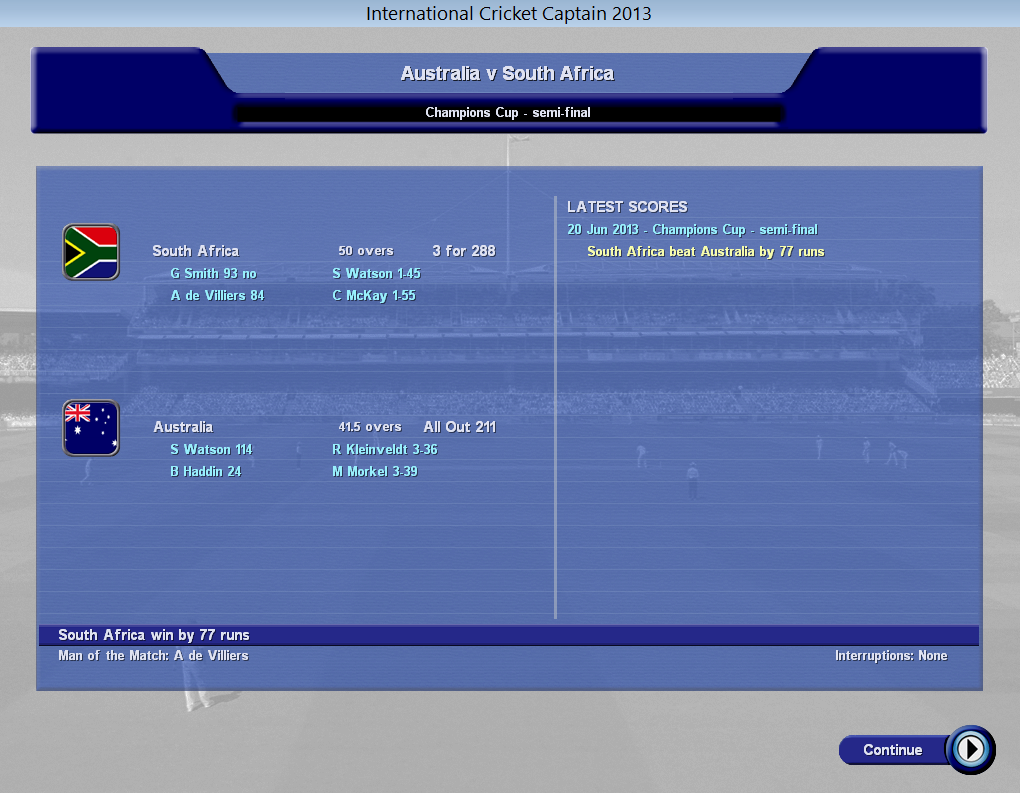
A gradual but inevitable descent into cricket-based loathing and bile.
No Such Thing As A Free Launch: International Cricket Captain 2013
A lot can change in a year. An unpopular Australian Prime Minister can be replaced by a slightly less unpopular one. England’s economic forecast can swing from “in the shit” to “even deeper in the shit”, and the world’s least read cricketing blog can add the world’s least listened to podcast to its repertoire. So it’s nice in these heady days of rapid change to have a constant you can fall back on and the International Cricket Captain series is definitely that. Like putting on an old pair of slippers, firing up each new installment of the series is an entirely predictable experience, yet no less a satisfying one for that. Sure they might be getting on a bit, and each year the moths seem to have taken a greater toll, but, well, we think we’ve taken this tortured analogy about as far as it can go really.
The list of new features introduced in International Captain 2013 is rather small, and in truth much of what we wrote about the previous version can be applied to this. Indeed most of the new ‘features’ can be more properly described as ‘tweaks’. For instance, one day games seem to be progress at a rather more believable pace now, with a noticeable increase in the scoring rate in the latter overs. They also seem to suffer from fewer inexplicable lulls, which previously used to occur even when you have both batsmen set to full aggression and were screaming at the monitor for the bastards to get a move on. It is claimed that there have been improvements to the in-game animations, particularly for close in catches, but we couldn’t spot anything noticeably different. Not that we can claim to be experts in the field of computer animations however. We still think the little toe tapping animation Sonic would make when you left him standing still too long is the greatest achievement in programming history.

Damn. Knew I should have picked Mitch Marsh.
The introduction of the ability to play matches involving some of the sport’s legends (although for some reason the developers have also included Ian Botham in that list) is a nice touch. Sure, it adds nothing to the core game, but it’s a pleasant diversion, and who doesn’t want to play with a team that has Bradman in it? There is even the option of replaying full historic tours, such as the 1948 or 2005 Ashes. We would like to see the concept taken further, however; the possibility of re-enacting England’s 2007 World Cup campaign, for instance, would be an extremely attractive one to all those masochists out there. Improvements to the online side of things will no doubt be welcomed by those who venture into the seedy underworld of multi-player cricket management.
The other changes to the game are mostly concerned with stuff going on behind the scenes, improvements to way new players are generated, how statistics are handled and so on. All of which means that long term careers are more enjoyable than before as nurturing young prospects, and pouring over pages of statistics, are what management games are really all about. That and trying to shoe-horn Steve Smith into every Australian side possible.
However whilst the continuity in the series means the developers can continue to refine the experience, to the point that the game represents the best simulation of the cricketing world available, it means the shortfalls of previous versions are carried along as well. For years the game has suffered from an appalling lack of player feedback, and this year’s version is no different in that regard. Very few of the decisions you make in the role of manager or captain will be anything other than complete guesses. There is a dearth of tooltips to inform the player of what any of the choices available actually mean. The training system in particular is horrible in this regard, with no feedback as to what any of the options mean, how they are affecting a player’s development, and when, or even if, you are likely to see any improvement. Developing your players essentially boils down to taking a punt on one prospect over another, based largely on their average, and hoping that it turns out to be the right one. Which is all a bit too close to England in the 90’s for our liking.
Equally trying to discern any information from the match engine is a fruitless endeavor. Is a batsman struggling against a certain bowler, not handling the short stuff well, or looking to get on top of the attack? Good luck trying to figure anything like that out from the match engine. At best you can observe that a player is struggling if they are playing and missing a lot outside off (otherwise known as the David Warner leave), but that’s about it, and it’s not as if you can really do a lot about it either aside from increase the bowler’s aggression and, well, hope for the best. Trying to set intelligent fields is likewise devoid of any real meaning. Sure if you watched games ball by ball you might be able to discern patterns and react accordingly but ain’t nobody got time for that. Well, we hope not anyway.
All of which means is that the game is an intrinsically frustrating experience. If you treat it all as a bit of fun, and just want to see how Steve Smith would go opening the batting for Australia in the Ashes (rather well), or how Don Bradman would do trying his hand at that T20 stuff (not so well), it’s great fun. It’s just that when you start taking things a bit more seriously and actually try and win games, or turn a hopeless County outfit like Somerset into something halfway respectable, you begin to hit brick walls. The lack of feedback means that playing a long term game is neither as deep nor as rewarding as it could otherwise have been.
Until the developers are prepared to let gamers take a peek ‘underneath the hood’, and let them make decisions based on a greater pool of information than just an average and a few statistics, the series will always stop short of becoming truly addictive, which is the sign of a great game. Which is not to say that it’s a bad game: it’s by far the best cricket management game available, it’s just that at the moment trying to get the most out of it is akin to Warner making an educated guess as to what he should do on the night after a game: sometimes you get things right, but other times things can go very, very, wrong. And much like Mickey Arthur, you are completely clueless as to how things are going to turn out beforehand.
Hey, maybe it really is an accurate simulation of the life of a cricket coach after all.



No Comments
Post a Comment